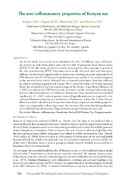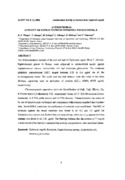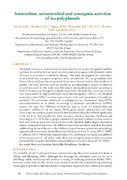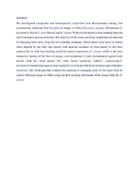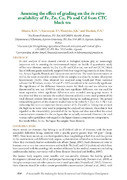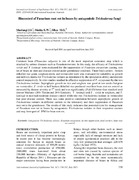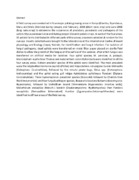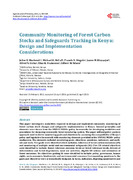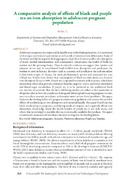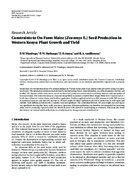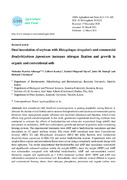Browsing Department of Crop Science by Title
Now showing items 1-20 of 60
-
Allelic Variation of Terpene Synthases Drives Terpene Diversity in the Wild Species of the Freesia Genus.
(2023-03-18)Terpene synthases (TPSs) play pivotal roles in conferring the structural diversity of terpenoids, which are mainly emitted from flowers, whereas the genetic basis of the release of floral volatile terpenes remains largely ... -
The anti-inflammatory properties of Kenyan tea
(2015)An in vivo study was carried out to determine the effect of different types of Kenyan tea extracts on male Swiss albino mice infected with Trypanosoma brucei brucei isolate KETRI 2710. The isolate produced a similar ... -
Antimicrobial acitivity of extracts from Tephrosia vogelii Hook F.
(2007-01-29)The dichloromethane extracts of the root and leaf of Tephrosia vogelii Hook F. (Family: Papilionaceae) grown in Kenya, were subjected to antimicrobial assays against Staphylococcus aureus, Escherichia coli and Fusarium ... -
Antioxidant, antimicrobial and synergistic activities of tea polyphenols
(2015)Microbial resistance to conventional antibiotics has become an increasing global problem and there is a need to find out novel, potent antimicrobial agents with alternative modes of action as accessories to antibiotic ... -
Article Navigation JOURNAL ARTICLE Evidence for Potential of Managing Some African Fruit Fly Species (Diptera: Tephritidae) Using the Mango Fruit Fly Host-Marking Pheromone
(Entomological Society of America, 2012-12-01)We investigated conspecific and heterospecific oviposition host discrimination among four economically important fruit fly pests of mango in Africa (Ceratitis capitata, Wiedemann; C. fasciventris, Bezzi; C. rosa, Karsch, ... -
Assessing the effect of grading on the in vitro availability of Fe, Zn, Cu, Pb and Cd from CTC black tea
(2015)In vitro analyses of trace element content in biological systems play an increasingly important role in assessing the environmental impact on health. A quantitative study of five trace elements namely Fe, Zn, Cu, Pb and ... -
Assessment of Production Constraints and Contribution of Avocado to Food Security and Income in the Mount Kenya Region, Kenya
(2023)Avocado (Persea americana Mill.) belongs to the family Lauraceae and it is an important crop to rural communities and economies in Kenya. Currently, avocado is grown in several agro ecological zones mainly by small-scale ... -
An Assessment Of The Physiological Quality Of Sorghum (Sorghum Bicolor L Moench) Seeds Planted By Farmers In Bomet District Of Kenya
(African Journal of Food, Agriculture, Nutrition and Development, 2012-08)Sorghum (Sorghum bicolor L. Moench) is an important crop that enhances food security in a region. As a food crop, sorghum is nutritious, containing starch (75-79%) as the major component, followed by protein (6.0-16.1%) ... -
Biocontrol of Fusarium root rot in beans by antagonistic Trichoderma fungi
(International Journal of AgriScience, 2013-07)Common bean (Phaseolus vulgaris) is one of the most important economic crop which is attacked by serious diseases such as Fusarium root rot. In this study, the efficacy of Trichoderma viride and T. koningii were evaluated ... -
Biological control agents of aphids (Homoptera: Aphididae) on potatoes (Solanum tuberosumL) in Kenya
(2010)A field survey was conducted in four major potato growing areas in Kenya (Kiambu, Nyandarua, Meru and Molo Districts) during January and February, 2008 (short rains crop) and June 2008 (long rains crop) to determine the ... -
Biorational Preservation of Rose (Rosa hybrida L.) Cut-Flower Using Stevia (Stevia rebaudiana B.) and Thyme (Thymus vulgaris L.) Extracts
(SciPress Ltd, 2018)Rose cut flower is one of the widely grown cut flowers in Kenya. However, most roses have a challenge of short vase life. This study aimed at determining the efficacy of plant extracts from thyme and stevia in preservation ... -
Bradyrhizobium inoculation has a greater effect on soybean growth, production and yield quality in organic than conventional farming systems
(2021-06-22)Globally, organic farming and bradyrhizobia inoculation are gaining popularity as agronomically and environmentally sound soil management strategies with great potential to alleviate declining soil fertility, maintain ... -
Community Monitoring of Forest Carbon Stocks and Safeguards Tracking in Kenya: Design and Implementation Considerations
(Scientific Research Publishing Inc, 2015-04)This paper investigates modalities required to design and implement community monitoring of forest carbon stock changes and safeguards implementation in Kenya. General principles and elements were drawn from the UNFCCC ... -
A comparative analysis of effects of black and purple tea on iron absorption in adolescent pregnant population
(2015)Adolescent pregnancy is a major public health issue in developing countries. It is associated with unique nutritional requirements as well as risk of micronutrient deficiencies. Some of the foods and drinks ingested ... -
Constraints to On-Farm Maize (Zea mays L.) Seed Production in Western Kenya: Plant Growth and Yield
(ISRN Agronomy, 2012)Studies have shown that that about 85% of maize farmers in Western Kenya plant local varieties with about 80% using own farm-saved seeds. The production system is characterized by late harvesting, heavy striga infestation, ... -
Control of Bacterial Wilt in Tomato Using Chitosan Intercalated with Tea Extracts.
(OJS/PKP, 2022-04-21)In this study, tea extracts were intercalated in chitosan gel to enhance the inhibitory effect of the complex on bacterial wilt in tomato. The disease caused by Ralstonia solanacearum can result in 100% crop loss under ... -
The Critical Onion Growth Stages For Selective Protection From Thrips Tabaci Lindeman (Thysanoptera:Thripidae) Infestation
(Kenya Agricultural Research Institute, Nairobi (Kenya), 2006-01)Field trials were conducted during 2000-2001 at KARIandrsquo;s Mwea-Tebere and Kiboko farms to establish the effect of onion thrips, Thrips tabaci Lindeman on onion bulb yields and to identify the critical onion growth ... -
Crop Production in Irrigation Schemes in Turkana County, Kenya, Before and During COVID-19 (2018-2021)
(2023-08-11)Turkana County, located in the northwest of Kenya, is an arid county and the poorest in the country, with a poverty index of 79.3% vs. 34.4% for the country. Due to its aridity, crop production is severely ... -
Do Mixed-Species Legume Fallows Provide Long-Term Maize Yield Benefit Compared with Monoculture Legume Fallows?
(Wiley, 2009-11-01)The deliberate planting of fast-growing N2–fixing legume monoculture species in rotation with cereal crops can be an important source of N for soil fertility replenishment. We hypothesized that mixed-species fallows have ... -
Dual inoculation of soybean with Rhizophagus irregularis and commercial Bradyrhizobium japonicum increases nitrogen fixation and growth in organic and conventional soils
(AIMS Agriculture and Food, 2021)Soil amendment with beneficial microorganisms is gaining popularity among farmers to alleviate the decline ofsoil fertility and to increase food production and maintain environmental quality. However, farm management greatly ...

